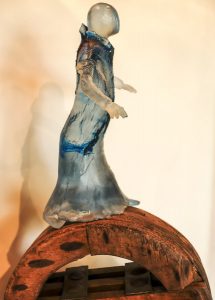” I shut my eyes in order to see ”
Paul Gauguin
Seeing art when you meet it, creates an instant connection between the work of the artist and yourself, the viewer.
When I visited a glass studio a few months ago, I was moved by a particular work of art. Moved, because it was not just another ‘wheel of Samsara’ – the prison of endless cycles of birth and death. This sculpture celebrated the challenges of life – with all its ups and downs. It was alive, dynamic, giving new meaning – a sculpture made out of coloured glass by the artist Diane Ferland.

My visceral response had clicked into place spontaneously and unexpectedly. For a moment I was at one with what I had seen. It had become alive and ceased to be just an object – a direct experience, unfiltered by thoughts, ideas, imagination or concepts. I realized I had entered into a relation that spoke to me. This encounter allowed me to be present for a short period. In these instances the artist and we, the viewer, share and live a moment of creativity.
Shortly after such an encounter one bounces back to the habitual way of seeing. Locked again into a static, conceptual viewpoint, one sees the sculpture as an object, a thing that is frozen in time. One is no longer in a relation. No longer being in a relation means one is no longer present. One’s viewpoint has shifted from the inside to the outside or from a life view to a fixed view. We tend to ignore this possibility to switch back and forth and pay attention only to outside experiences by maintaining our attachment to a conceptual way of seeing. We believe this is the only available reality, the only reality that counts.
Photography and the two ways of seeing.
The twofold attitude of seeing is always present in various degrees but not easily accessible. As mentioned above, the conceptual way of seeing is the conventional one. By identifying with that approach one’s ego-self is in charge. Seeing from this platform provides certain stability, security, and objectivity that can be defined, analyzed and manipulated in endless ways. One may call it ‘seeing with form’.
The other is a direct encounter, entering into a relation that is open and inclusive. As much as possible one is involved in it. There is a loosening, a melting away of conceptual structures that habitually interfere with our seeing. These hardened structures begin to crack and become more flexible so creativity can shine through. We may call this kind of seeing ‘formless‘ because it is not deliberate and therefore can not be defined.

I’m impressed, I need to say. Really rarely do I encounter a weblog that’s each educative and entertaining, and let me inform you, you have got hit the nail on the head. Your concept is outstanding; the difficulty is something that not enough individuals are speaking intelligently about. I’m very comfortable that I stumbled across this in my search for something referring to this. http://hellowh983mm.com
Thank you very much!